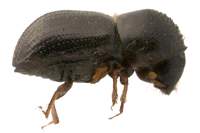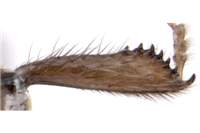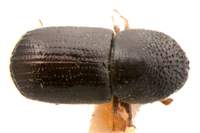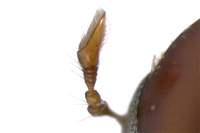Diagnosis
Black, stout. Temperate species mostly hairless, tropical species distinctly hairy. Pronotal base with distinct mycangial tuft (mycangium not visible externally). Antennal club clearly flattened, protibiae triangular and slender, with conspicuous denticles.
Siimilar to Xylosandrus, but procoxae contiguous, not separated as in Xylosandrus. Similar to Cnestus, but pronotum and elytral declivity obliquely costate laterally, not carinate.
Distribution
Uncommon but widespread genus, occuring in both temperate and tropical forests worldwide, probably with the expception of South America.
Biology
Short tunnels with usually rich growth of symbiotic fungus.
Taxonomy
Possibly a basal branch in a rich clade of mostly Palaeotropical species with mesonotal mycangium: Anisandrus, Eccoptopterus, Xylosandrus, Cnestus, Hadrodemius.
Detailed description
Eyes shallowly emarginate or almost entire, only very slightly emarginate, upper portion of eyes smaller than lower part. Antennal club more-less circular in shape, or taller than wide, club type one (truncated, first segment covering posterior side). First segment of club circular around the club, covering the entire posterior face, margin of the first segment clearly costate all around the antenna. Second segment of club narrow, pubescent, visible on the anterior side only. Third segment of club absent from the posterior side of club. First segment of antennal funicle shorter than pedicel, or longer than pedicel, its base stalk-like, funicle composed of 4 segments, scapus appears long and slender. Frons above epistoma rugged, coarsely punctate. Submentum slightly impressed, shaped as a distinct large triangle, or as a very narrow triangle. Anterior edge of pronotum with two or more flat asperities protruding anteriad. Pronotum from lateral view tall (type 3), or rounded and robust (type 5). From dorsal view it is conical (type 0), or rounded (type 1). Pronotal disc is densely and evenly punctured, often with abundant setae in tropical species. Lateral edge of pronotum is obliquely costate, often with a pointed shoulder. Procoxae narrowly separated, prosternal posterocoxal process short, conical or flat, inconspicuous. Tuft on pronotal basis associated with mesonotal mycangium often very distinct and dense; no setae on elytral bases indicating the presence of elytral mycangium. Scutellum flat, flush with elytra. Elytral bases straight, with oblique edge, elytral disc very short compared to the declivity, and usually convex. Punctures on elytral disc confused in tropical spesies, in straight lines in temperate species. Elytral summit rounded and smoothly transitioning into declivity. Lateral profile of elytral declivity flat or rounded, dorsal profile of elytral apex rounded, or broadened lateraly. Elytral declivity covered with dense erect setae more abundant than strial punctures. Posterolateral declivital costa absent or undefinable in tropical species. Inner part of declivity has no tubercles, or only uniform granules, some species have minor tubercles at apex of elytral declivity. Protibiae slender on upper part, broad and denticulate on lower part. Posterior side of protibia flat, with setae only. Protibial denticles large, distinctly longer than wide, bases of the denticles distinctly enlarged, conical, between 6 and 8 protibial denticles present. Metatibiae of normal size. Uniformly dark brown or black. Medium to large species, robust, 2.5-4.3 mm.





